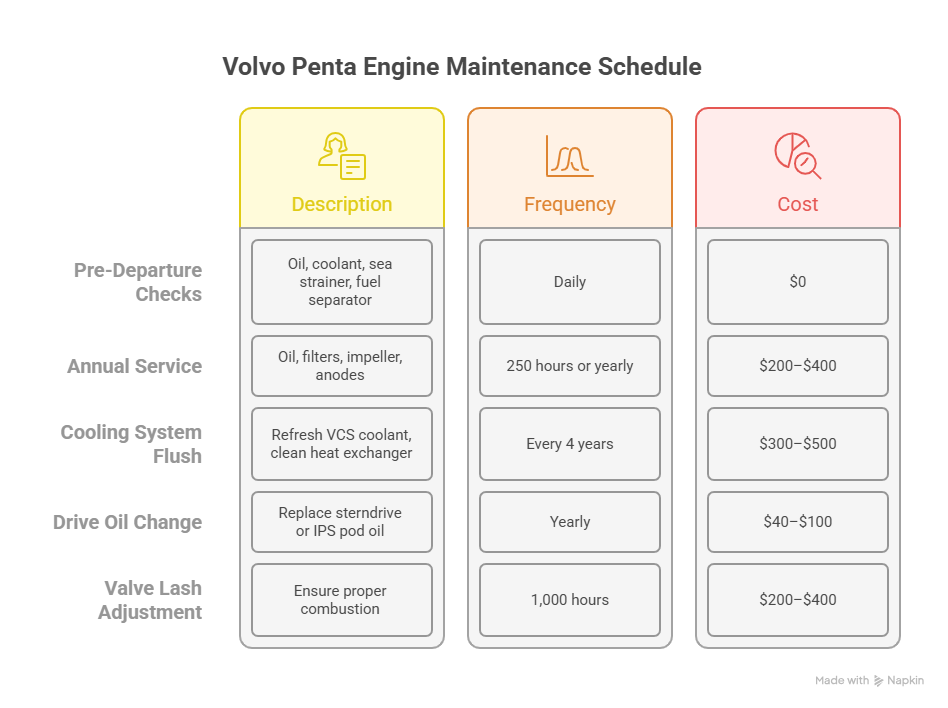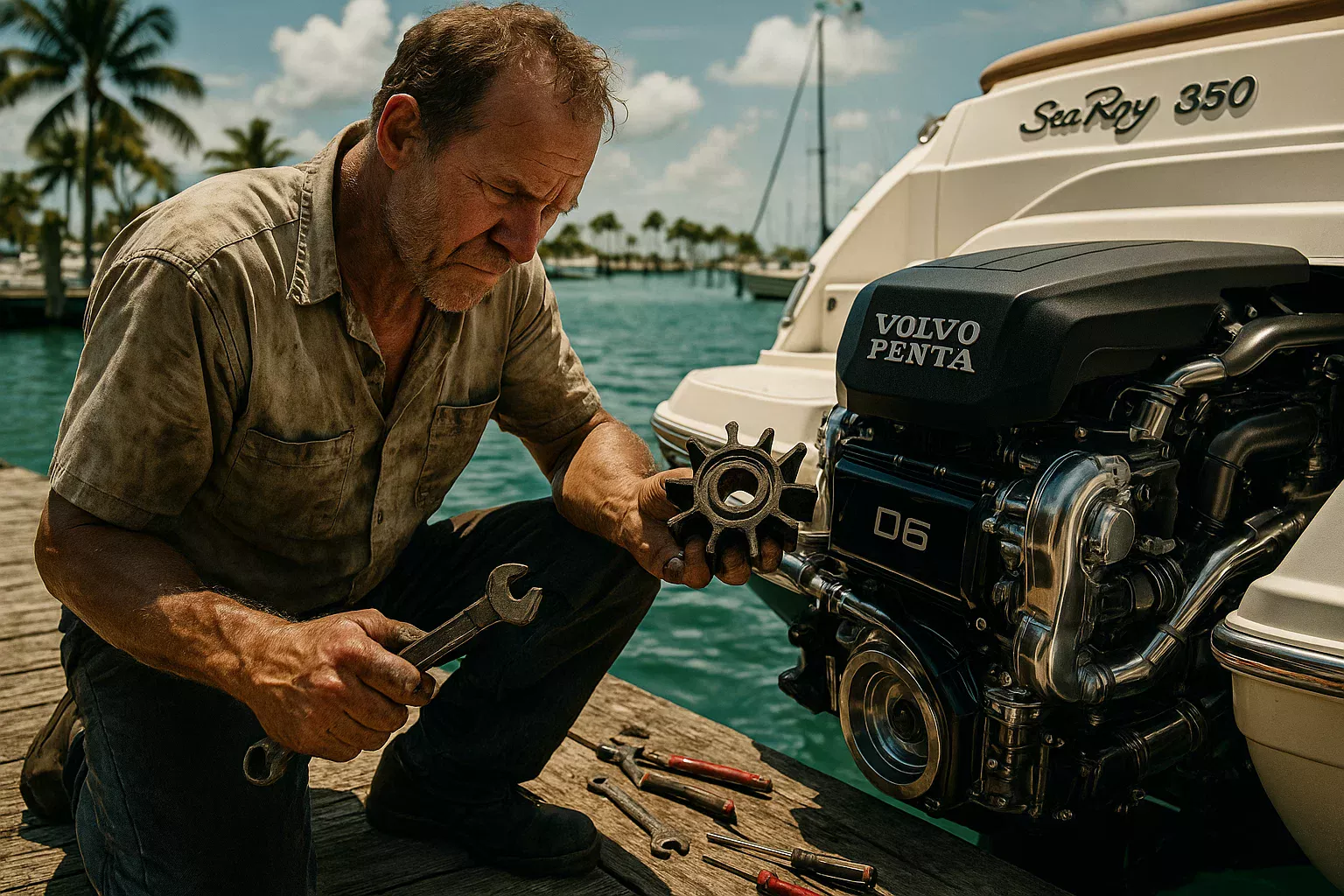Volvo Penta Engine Maintenance: 15 Years of Lessons from Miami’s Marinas
I’ve been wrenching on Volvo Penta engines for 15 years, mostly in the salty, humid marinas of Miami and Fort Lauderdale. Last June, a client named Carlos rolled into Dinner Key with his 2021 Volvo Penta D6-powered Sea Ray 350, cursing about a “weird overheating issue.” Weird? Nah. It was a classic worn impeller—$25 part, $1,500 tow if you ignore it. I’ve seen this a hundred times, and it’s always the same: skip the small stuff, and you’re stuck on the water. Here’s my battle-tested guide to keeping your Volvo Penta purring, based on real-world fixes and a few hard-learned mistakes.
Why Do Volvo Penta Engines Fail on the Water?
Most breakdowns aren’t rocket science—they’re simple maintenance oversights. I’ve towed boats from Stiltsville to Key Biscayne, and 80% of the time, it’s cooling, fuel, or electrical issues. A buddy, Javier, learned this the hard way last summer when his D4’s fuel filter clogged, leaving him stranded with a $2,000 repair bill. Stick to a solid maintenance routine, and you’ll avoid these headaches. Let’s break down the essentials.
What’s the “Whichever Comes First” Rule?
Volvo Penta’s maintenance hinges on one rule: service based on operating hours or calendar time—whichever hits first. Even if your boat sits at the dock, time degrades parts. Rubber impellers dry out, oil picks up moisture, and anodes corrode. I learned this back in 2010 when a client’s idle D6 seized up—$8,000 fix because he skipped annual checks. Log hours and dates religiously to stay ahead.
Why Is the Owner’s Manual Your Bible?
Your Volvo Penta manual isn’t optional—it’s the gold standard for your engine’s needs. A D4’s oil spec (VDS-4.5, 15W-40) differs from a D6, and IPS drives have unique quirks. I keep a PDF of my manuals on my phone—saved me last month when I needed the exact impeller part number for a client’s IPS600 at Bahia Mar. Download yours from Volvo Penta’s site, and jot down key specs: oil type, coolant (VCS Yellow or Green), and filter numbers. Takes 15 minutes, saves thousands.
How Do I Start a Maintenance Log?
A good log is your engine’s résumé—proof it’s been cared for, great for resale. I use a waterproof notebook, but a boating app works too. After every service, I note the date, engine hours, tasks (e.g., oil change, impeller swap), part numbers, and observations—like milky oil or worn anodes. Last year, my log helped a client at Coconut Grove win a warranty claim on a $3,000 fuel pump. Consistency’s the key.
What Are the Core Service Intervals?
A solid schedule keeps your engine ready. Here’s what I’ve learned from 200+ Volvo Penta jobs in South Florida.
What Should I Check Before Every Trip?
Five minutes before casting off can save your day. I check these on my Boston Whaler every time:
- Oil and Coolant: Check levels cold for accuracy. Low coolant cost a guy at Key Biscayne $1,200 last July.
- Fuel Water Separator: Drain water to protect injectors. I caught contamination on a D6 last month—saved the engine.
- Sea Strainer: Clear seagrass or debris for water flow. Takes 30 seconds.
- Visual Scan: Look for leaks, loose belts, or frayed hoses.
What’s the Annual Service Must-Do List?
At 250 hours or once a year—whichever comes first—hit these essentials:
- Engine Oil and Filter: Swap to remove acidic gunk. I use VDS-4.5, $50 a gallon.
- Fuel Filters: Change both pre-filter and fine filter. Clogged filters killed Javier’s D4 last summer.
- Raw Water Impeller: Replace this $25 part to avoid overheating. I swap mine every spring, no exceptions.
- Sacrificial Anodes: New zincs for saltwater protect your engine. I check mine with a multimeter—saved $500 in corrosion repairs last year.
What About Long-Term Maintenance?
Every 2–4 years (500–1,000+ hours), dig deeper:
- Cooling System Flush: Refresh coolant every four years to maintain efficiency. I flushed a D6’s VCS Yellow last spring—took two hours, saved $2,000.
- Air System: Clean or replace air and crankcase filters for airflow. A dirty filter cut a client’s power by 10% in 2024.
- Valve Lash Adjustment: At 1,000 hours, this keeps combustion tight. I use a feeler gauge—did one on a D4 at Fort Lauderdale last month.
How Do I Protect the Cooling System?
Cooling failures cause 50% of the tows I see. Volvo Penta’s dual circuits—raw water and closed coolant—need constant attention.
Why Is the Impeller Non-Negotiable?
A worn impeller means overheating, fast. I check for weak exhaust water flow or high temps at RPM. Last June, Carlos’ Sea Ray hit 220°F because of a cracked impeller—$1,500 tow. I replace mine annually, $25 part, 20 minutes. Don’t wait for failure.
How Do I Maintain Sea Strainers and Anodes?
Clear the sea strainer basket before every trip—debris starves the engine of water. I caught seagrass clogging a D6’s strainer at Stiltsville last summer. For anodes, use zinc for saltwater, aluminum for brackish. I test mine with a multimeter; 0.2V means they’re shot. Saves $500 in corrosion damage.
What’s the Deal with Coolant?
Use only Volvo Penta VCS Yellow or Green—mixing types gels and clogs passages. I saw a D4’s heat exchanger fail from mixed coolant in 2023—$3,000 fix. Flush every four years, and check levels monthly. I use a refractometer to test freeze protection; caught a weak mix last winter.
How Do I Keep Fuel and Oil Clean?
Dirty fuel or oil kills performance. Here’s my approach from 15 years of fixes.
What Oil Should I Use?
Stick to diesel-rated oil like VDS-3, 15W-40, per your manual. I change oil and filters every 250 hours or yearly—takes 30 minutes, costs $60. Check drained oil for milky water or metal flakes. A milky batch on a D6 last year tipped me off to a $1,000 leak.
How Do I Prevent Fuel Contamination?
Volvo Penta’s dual filters—pre-filter and fine filter—are your defense. Swap them annually. I cut open old filters to check for diesel bug (microbial gunk). Found it on a client’s IPS600 last July—$2,500 tank cleaning. Drain the water separator daily and use high-quality fuel from marinas like Bahia Mar.
What Else Needs Attention?
Your engine’s only half the story. Drives, transmissions, and electrical systems matter just as much.
How Do I Maintain the Drivetrain?
For sterndrives or IPS pods, change drive oil yearly—$40 for fluid. I inspect rubber bellows for cracks; a tiny split sank a boat off Key Biscayne in 2022. Check steering and trim for leaks. I use a torque wrench for bellows clamps—did one on a D6 last month. For conventional transmissions, sync fluid changes with engine oil.
What About Electrical Systems?
Salt air eats connections. I check battery terminals, starter, and alternator yearly, spraying with corrosion inhibitor—$10 can. Loose terminals killed a client’s D4 at Coconut Grove last summer—$200 fix. Test under load with a multimeter to catch voltage drops.
How Do I Winterize Properly?
Winterization isn’t just for cold climates—it’s about pausing your engine right. I learned this after a $1,500 repair from bad fuel in 2015.
- Stabilize Fuel: Add stabilizer to a full tank to stop moisture. I use Sta-Bil, $15 bottle.
- Change Oil Before Storage: Fresh oil prevents corrosion. I swap mine in November—takes 30 minutes.
- Flush with Antifreeze: Run non-toxic antifreeze through raw water circuits. I use West Marine’s brand, $20/gallon.
- Loosen Belts: Prevents flat spots. I loosen mine a quarter-turn before layup.
Spring commissioning is then just a checklist: tighten belts, check fluids, test run. Saved me $500 last spring.

FAQ: Common Volvo Penta Maintenance Questions
How Often Should I Service My Volvo Penta Engine?
Every 250 hours or annually, whichever comes first. I swap oil, filters, impellers, and anodes yearly—cost me $200 last spring on my D6. Check your manual for specifics. A shop like Miami Marine (miamimarine.com) can help if you’re not DIY.
What Happens If I Skip Impeller Replacement?
You’re asking for a tow. A worn impeller caused Carlos’ $1,500 breakdown last June. Replace it annually—$25 part, 20 minutes. Prevents overheating, per Volvo Penta’s 2025 maintenance guide.
Can I Use Any Coolant in My Volvo Penta?
No way. Use VCS Yellow or Green only—mixing gels passages. I saw a $3,000 repair from wrong coolant in 2023. Check your manual and test with a refractometer. Available at West Marine.
How Do I Spot Fuel Contamination?
Drain the water separator daily; look for cloudy fuel. I cut open filters to check for diesel bug—found it on an IPS600 last July. Use high-quality fuel from marinas like Bahia Mar. Costs $50 to prevent a $2,500 fix.
Why Change Oil Before Winter Layup?
Acidic oil corrodes internals during storage. I learned this after a $1,000 repair in 2015. Change oil and filters before layup—$60, 30 minutes. See Volvo Penta’s 2025 guide.
How Do I Check Anodes?
Use a multimeter; 0.2V means they’re done. I caught failing zincs on a D4 last month—saved $500. Replace yearly with zinc for saltwater. West Marine stocks them.
What’s the Best Maintenance Log Tool?
I use a waterproof notebook, but apps like BoatCloud work. Log date, hours, tasks, and part numbers. My log won a $3,000 warranty claim in 2024. Takes five minutes per service.
Why Are Bellows So Critical?
A cracked bellows can sink your boat. I saw one off Key Biscayne in 2022—$10,000 loss. Inspect annually with a flashlight; replace every 2–3 years. Miami Marine offers inspections.
Table: My Volvo Penta Maintenance Schedule
I built this from 15 years of jobs in South Florida:
| Task | Description | Frequency | Cost |
|---|---|---|---|
| Pre-Departure Checks | Oil, coolant, sea strainer, fuel separator | Daily | $0 |
| Annual Service | Oil, filters, impeller, anodes | 250 hours or yearly | $200–$400 |
| Cooling System Flush | Refresh VCS coolant, clean heat exchanger | Every 4 years | $300–$500 |
| Drive Oil Change | Replace sterndrive or IPS pod oil | Yearly | $40–$100 |
| Valve Lash Adjustment | Ensure proper combustion | 1,000 hours | $200–$400 |
Why Does Maintenance Matter?
A solid routine isn’t a chore—it’s freedom. I’ve seen too many boaters stuck off Stiltsville, cursing a $2,000 tow that a $25 impeller could’ve prevented. Follow the “whichever comes first” rule, stick to your manual, and log everything. My D6’s still running strong after 10 years, and my log boosted its resale value by $5,000 last year. Spend a few hours now, or pay thousands later.
Author Bio
I’m Alex, a 15-year marine mechanic in South Florida with ABYC certification since 2009. I’ve serviced 200+ Volvo Penta engines, from D4s to IPS600s, across Miami and Fort Lauderdale.


Leave a Reply